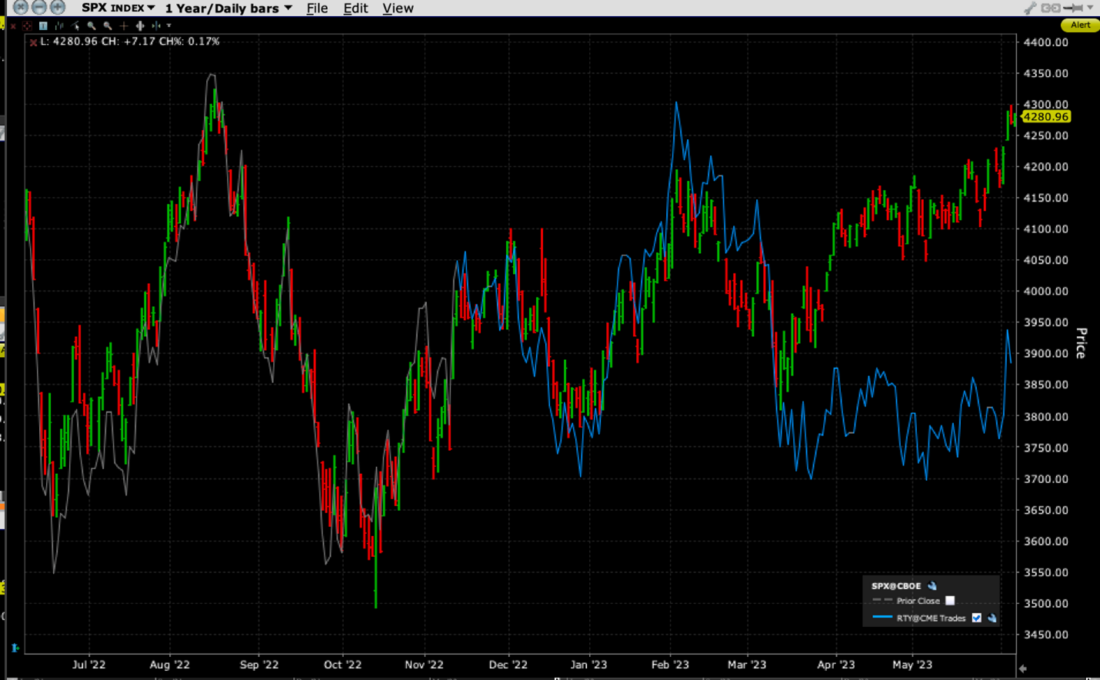There has been no shortage of hand-wringing about the narrow leadership of the current rally – myself included. Although the majority of the divergences remain largely in place, an interesting development has been taking place over recent sessions. The best performing US index has been the most broad-based and economically sensitive of all – the Russell 2000 (RTY).
To put it plainly, RTY has been ripping since Thursday. It’s clearly not a long-term trend, but its outperformance – particularly since Friday – has been stunning.
1-Week Chart, SPX (red/green 5-minute bars), RTY June Futures (purple line)

Source: Interactive Brokers
On Thursday, RTY roughly matched SPX’s 1% rise. But on Friday, RTY’s 3.56% leap far outpaced SPX’s 1.45%, and as I write this, RTY is up 2.7% with SPX up 0.23%. That said, RTY has been a major laggard over the past few months:
1-Year Chart, SPX (red/green daily bars), RTY (grey/blue line)


Source: Interactive Brokers
It is indeed welcome to see a rally broaden, but we have to wonder whether this is simply momentum traders cashing in and attempting to move into laggards rather than a meaningful vote about smaller stock outperformance. That the best performing sector today is regional banking, the poster child for recent underperformance, is a sign that the former may be the case. There is little fundamental reason for a 5% rally in that group, so it is undoubtedly a sector that has notable room to play catch up.
Regarding smaller stocks, they tend to outperform when the economy is robust. The logic for investing in RTY is essentially the polar opposite of the rationale for chasing large tech stocks. Even prior to the recent AI enthusiasm, the largest tech stocks were benefitting from the notion that their franchises were perceived as impenetrable in a slow-growth economy. Ask yourself now if the economic climate appears to be changing sufficiently to raise the tide for smaller stocks, many of which are unprofitable.
There is certainly nothing wrong with finding underperforming stocks and sectors. It’s what traders have been doing essentially forever, and pretty much the definition of “buy low, sell high” – at least when they rotate from the outperformers to the underperformers. The key decision becomes how far to chase the former underperformers when they pick up steam. If there is a solid investment thesis behind the sector in question, the timeframe for joining the fray is lengthened. If the logic is simply that there has been a temporary lag, then one needs to be quite careful about timing one’s exit.
Let’s see if there is real follow-through in the sectoral plays. If investment capital acknowledges that smaller stocks are investable asset in the current climate, then this would be a key sign of health for the equity markets. Yet we only see modest improvement so far in the advance/decline lines. They’ve stopped falling, but their rise is hardly commensurate with SPX and NDX, let alone RTY. For now, we’re encouraged by the recent change in leadership, but think it’s premature to say that it is much more than the latest trend for aggressive traders.
Join The Conversation
If you have a general question, it may already be covered in our FAQs. If you have an account-specific question or concern, please reach out to Client Services.
Leave a Reply
Disclosure: Interactive Brokers
The analysis in this material is provided for information only and is not and should not be construed as an offer to sell or the solicitation of an offer to buy any security. To the extent that this material discusses general market activity, industry or sector trends or other broad-based economic or political conditions, it should not be construed as research or investment advice. To the extent that it includes references to specific securities, commodities, currencies, or other instruments, those references do not constitute a recommendation by IBKR to buy, sell or hold such investments. This material does not and is not intended to take into account the particular financial conditions, investment objectives or requirements of individual customers. Before acting on this material, you should consider whether it is suitable for your particular circumstances and, as necessary, seek professional advice.
The views and opinions expressed herein are those of the author and do not necessarily reflect the views of Interactive Brokers, its affiliates, or its employees.




























Thank you for the insight. Let’s see how long the relative outperformance lasts